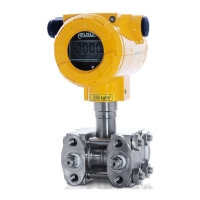A1 17 DTR.APC.APR.ALW.03
(ENG)
IV. FEATURES, INSTALLATION AND MAINTENANCE OF TRANSMITTERS
1. INTRODUCTION
1.1. This Manual is intended for users of APC-2000ALW smart pressure transmitters, APR-2000ALW,
APR-2200ALW, APR-2000GALW smart differential pressure transmitters, APR-2000YALW smart level probe,
APC-2000ALW/L smart level transmitter and their intrinsic-safety versions, containing the data and guidelines
necessary to understand the functioning of the transmitters and how to operate them. It includes essential
recommendations concerning installation and use, as well as emergency procedures. The parameters and
information specified for transmitters identified herein with the sign APC..., APR... also apply to transmitters:
APC-2000ALW, APR-2000ALW, APR-2200ALW, APR-2200GALW, APR-2000YALW, APC-2000ALW/L and
their explosion-proof versions, as well as all the variations differing by the type of the process terminals.
Information on the transmitter sizes and the method of installation apply to both, all versions of transmitters.
1.2. Technical data for the diaphragm seals and for the APC... and APR... transmitters are contained in the
catalogue cards “DIAPHRAGM SEALS”.
1.3. The transmitters comply with the requirements of EU directives as shown on the plate and with the relevant
Declaration of Conformity.
1.4. Additional data for APC-2000ALW, APR-2000ALW, APR-2200ALW, APR-2000GALW and
APR-2000YALW transmitters in Ex versions is contained in the appendix designed to
DTR.APC.APR.ALW.03
(ENG).
Exi Appendix and in Exd versions in the appendix designed to
DTR.APC.APR.ALW.03
(ENG).
Exd Appendix.
During installation and use of the transmitters in Ex or Exd version, reference should be made to
DTR.APC.APR.ALW.03
(ENG
) in conjunction with Exi or Exd Appendix.
1.5. The pressure transmitters: APC-2000ALW, APR-2000ALW in realization for sea uses are complied with
Det Norske Veritas (DNV) Rules for Classification of Ships, High Speed & Light Craft and Det Norske Veritas'
Offshore Standards. Certificate No. A -11308 for application in following Location Classes: Temperature C,
Humidity: B, Vibrations: B, EMC: B, Enclosure: C. The pressure transmitters: PCE-28, PCE-28P, PRE-28 in
realization for sea uses are complied with Det Norske Veritas (DNV) Rules for Classification of Ships, High
Speed & Light Craft and Det Norske Veritas' Offshore Standards. Certificate No. A -11308 for application in
following Location Classes: Temperature C, Humidity: B, Vibrations: B, EMC: B, Enclosure: C.
1.6. The APC…, APR… transmitters are also made in a version which complies with the PED Pressure
Directive, meet the requirements for category IV, and then carry additional markings as in 4.3.
1.7. Essential data relating to installation of APC-2000ALW transmitters in accordance with MID Directive
contains MID Appendix.
2. USER MATERIALS
Transmitters are delivered in single and/or multiple packs.
Together with the transmitter are delivered:
a) Product certificate, which is also as the warranty card
b) Declaration of conformity - on request
c) Copy of ATEX certificate – on request,
d) User’s Manual numbered: DTR.APC.APR.ALW.03
(ENG).
Items b), c), d) are available at: www.aplisens.pl
3. APPLICATIONS AND MAIN FEATURES
3.1. The APC... smart pressure transmitters are designed to measure gauge pressure, vacuum pressure and
absolute pressure of gases, vapours and liquids (including corrosive substances).
Differential pressure transmitters type APR… are used to measure liquid levels in closed tanks, with static
pressure up to 25MPa, or 32MPa for special versions and to measure differential pressure across constrictions
such as filters and orifices.
3.2. The transmitters may be fitted with a range of types of process connectors, which enables them to
be used in a variety of conditions such as thick or highly reactive media, high and low temperatures,
etc.
3.3. APC..., APR... transmitters generate a 4...20mA output signal and a digital HART signal in a two-wire
system (current loop). The use of smart electronics enables regulation of the zero point, the measurement
range, damping, radical conversion characteristic and other functions using an Aplisens KAP communicator or
from a PC using a Hart/RS232 or Hart/USB converter and Aplisens “Raport 2” configuration software.

